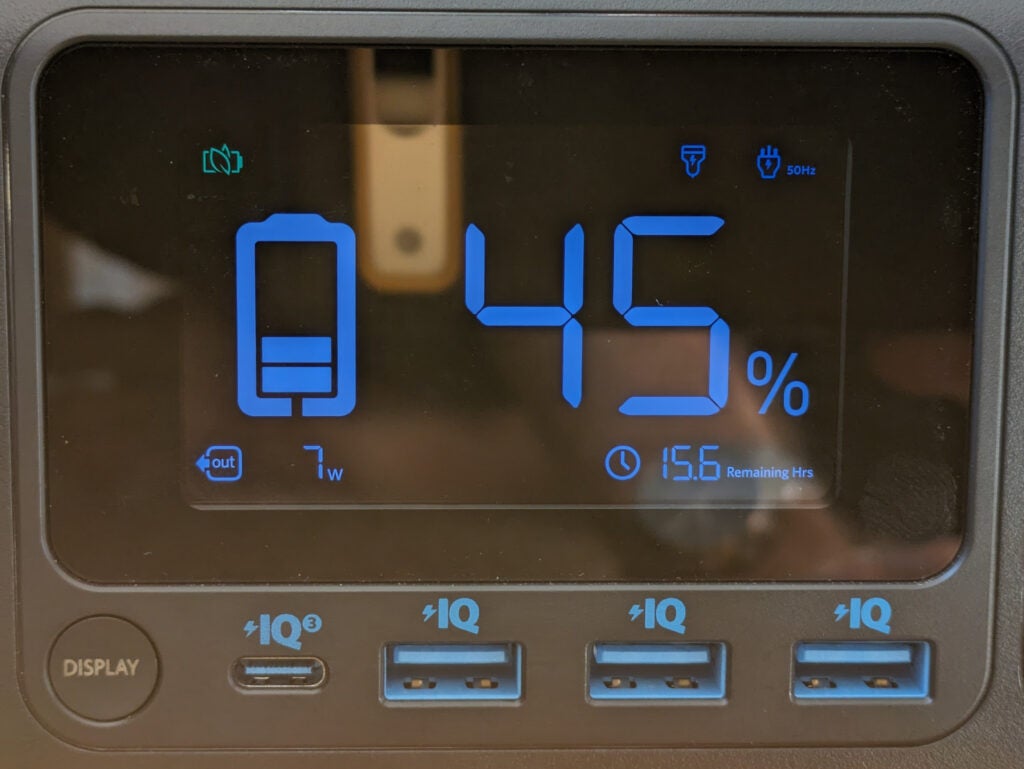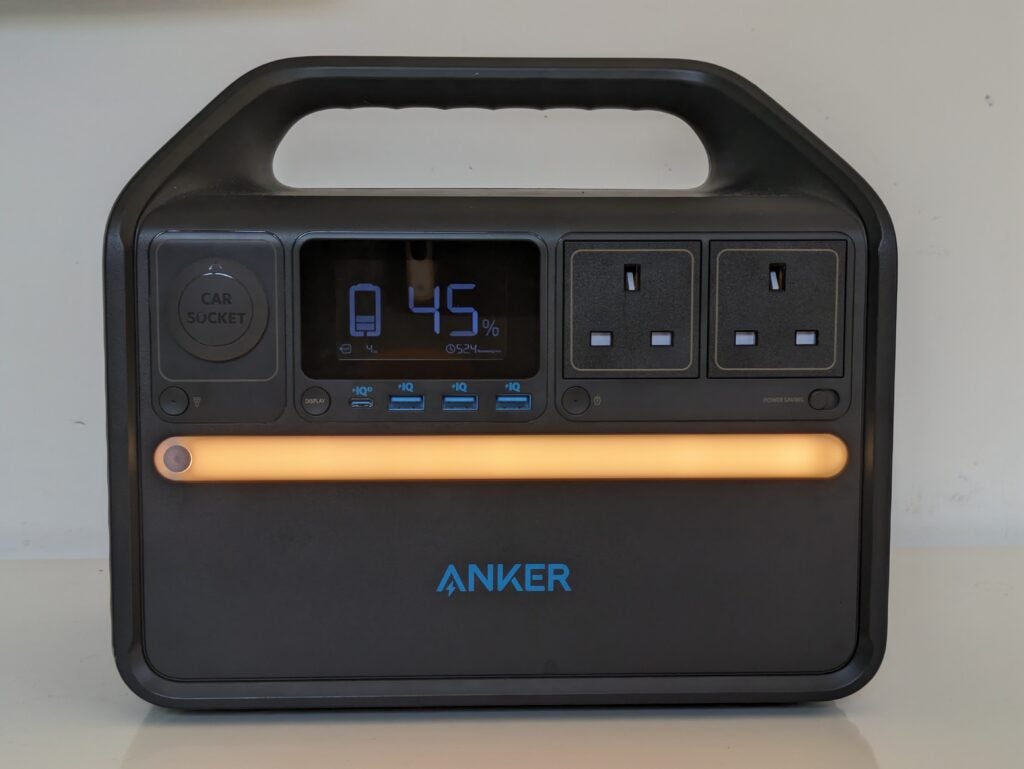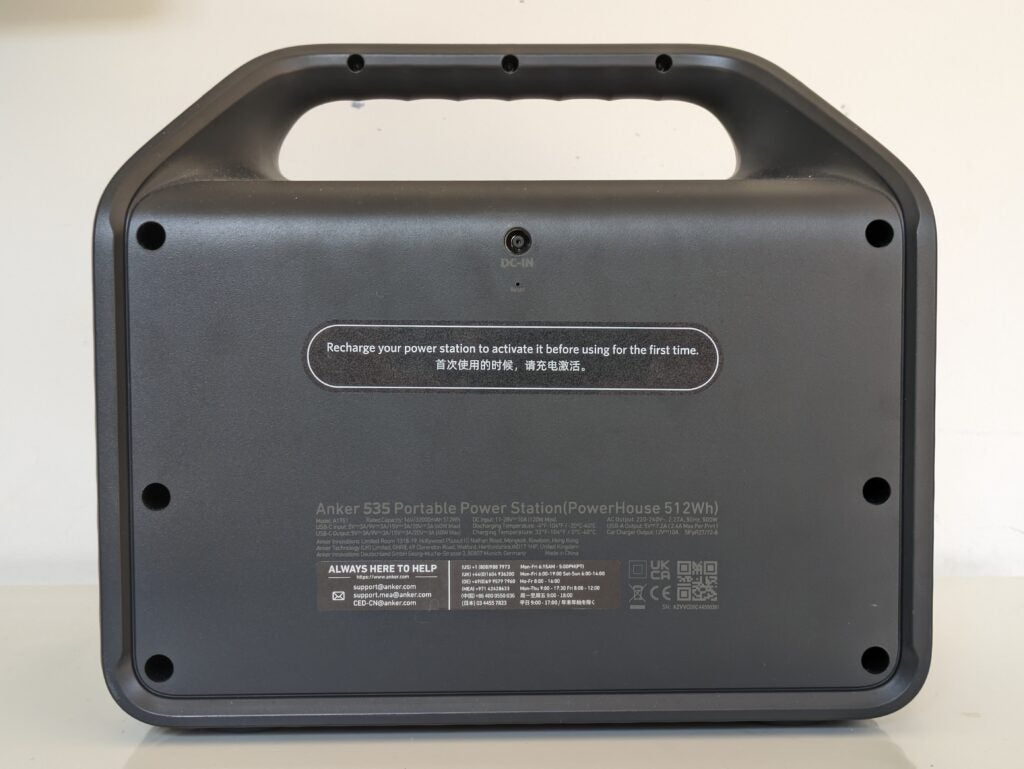[ad_1]
Verdict
The Anker PowerHouse 535 is a good selection for anybody needing a mid-range energy station for tenting journeys, or mild backup duties across the residence. It strikes a robust steadiness between energy storage and portability, affords versatile charging, and is likely one of the best energy banks we’ve examined. Whereas it’s not appropriate for heavy-duty home equipment, it’s perfect for computer systems, telephones, CPAP machines and different light-to-medium obligation devices.
Execs
- Glorious capabilities, good vary of ports
- Rugged, sensible design
- Very environment friendly
Introduction
The Anker PowerHouse 535 is the second mannequin up in Anker’s rising vary of residence energy stations, but it surely shares lots of the sturdy options discovered elsewhere within the lineup.
Maybe most significantly, it’s constructed round a set of lithium iron phosphate (LFP or LiFePO) batteries, which provide an extended service lifetime of 3000 or extra recharge cycles, and are typically held to be extra protected than different lithium cells. Anker says the PowerHouse 535 is designed for 10 years of operation, and it comes with a helpful five-year guarantee.
The 535 is in regards to the dimension of a four-slot toaster, and it’s not particularly heavy, making it pretty sensible for tenting journeys or shifting about the home. It affords versatile recharging, together with from the solar or in a automobile, and has output ports to cowl mains and USB-powered units. It could possibly retailer 512 watt-hours (Wh) of electrical energy – theoretically sufficient to energy a low-energy mild bulb for greater than two days – and has a peak mains output of 500W. It’s not splashproof, nonetheless, and it may overheat in sturdy daylight.
With a most energy output a couple of quarter of a typical washer or dishwasher, the 535 gained’t assist you do laundry in an influence lower. Nonetheless, it’s sufficient to deal with even comparatively highly effective PC and monitor combos, CPAP machines, or different low to medium energy devices. It’s not dangerous worth at its full worth of round £500, however on the time of writing we often noticed it discounted beneath £400.
Design and options
- Rugged and sensible with an honest display screen
- Good choice of ports and capabilities
- Considerate design and structure
The Anker PowerHouse 535 appears to be like a bit utilitarian, but it surely feels properly designed and made. On prime it has a thick deal with, whereas the underside’s giant rubber ft assist preserve it the place you set it. There are vents at all sides, and only a lone energy enter port on the again – a lot of the options are on the entrance panel.

This energy station affords two UK mains sockets, each managed by the identical on/off button and each sharing a mixed 500W most output. There’s additionally a 12V automobile energy socket providing as much as 100W, plus 4 USB sockets and a light-weight. That’s not a nasty choice, however I’ve a minor quibble with the selection of three USB-A ports – every rated at 12.4W – and just one 60W USB-C output. Increasingly units are adopting USB-C, so I’d desire to see not less than two of those ports.
I’ve no complaints in regards to the giant mono display screen, which reveals the battery cost at a look, together with the speed at which it’s charging or discharging, and the way lengthy both is prone to take. This additionally has indicators exhibiting when the USB ports are offering energy, and whether or not the power-saving mode is activated. This screens the load on the mains and automobile energy sockets, switching them off mechanically if it stays at a low determine – it’s essential to disable it should you’re utilizing the 535 as a backup energy supply for important tools.

I notably like this energy station’s LED strip mild, which provides off greater than sufficient smooth mild to dispel shadows when tenting with children, or stop barked shins in an influence lower.
It solely has one brightness degree, which consumes 4W, however you too can put it in an emergency mode which flashes ‘SOS’ in Morse Code. A minimum of, it’s meant to – in reality its dot-dot-dot, dash-dash-dash spells a fairly extra nonchalant ‘SO’.

Charging
- Cost from mains, automobile or the solar
- Most 180W enter
- No pass-through mode
This energy station affords an excessive amount of flexibility with regards to charging. You need to use the equipped 120W AC adaptor to completely cost it inside about 5 hours, or join a USB-C charger to the USB-C output port, which doubles up as an enter. Combining these permits you to cost at a most 180W, which will get the PowerHouse 535 as much as 80% cost in about two and a half hours.

You’ll additionally discover a automobile adaptor within the field. This once more permits you to totally recharge the 535 in about 5 hours, which could possibly be helpful should you’ve bought an extended drive between tenting websites. Lastly, you possibly can join as much as 120W of solar energy – certainly you should purchase the 535 bundled with a 100W panel, by which case it’s referred to as the Anker 535 Photo voltaic Generator.
There are some limitations. Mains, automobile and photo voltaic charging all use the only DC enter port on the again, so you possibly can’t mix them for a faster recharge. You’ll be able to, nonetheless, complement any of them with a USB-C enter. Extra considerably, the reliance on an exterior AC adaptor retains the 535 fairly compact, but it surely signifies that there’s no pass-through or bypass mode, which might, for instance, permit it to supply 500W of mains energy to its sockets whereas nonetheless recharging its battery. It can fortunately present some energy whereas charging, but when the overall load goes over 120W it’ll want to attract on battery energy, and the battery will in the end run down.

In observe this is probably not as a lot of a difficulty as it’s with the entry degree PowerHouse 521, which has a extra restrictive 65W adaptor. Most laptops and a few pc/monitor combos have a mean energy consumption beneath the 535’s 120W enter, which means it is going to stay charged total if it’s linked in sequence with them. In case you are pondering of utilizing it for backup energy, do test the tools you’ll be connecting – and bear in mind that there’s no alarm to warn you when the 535’s battery is sort of empty.
We take a look at the quantity of vitality wanted to completely recharge an influence station. It took simply 574Wh to replenish the Anker PowerHouse 535 which, assuming its 512Wh battery went from totally exhausted to completely recharged, equates to 89% effectivity. That’s one of the best efficiency I’ve but recorded. Curiously, I used a USB energy meter to measure how a lot electrical energy it took to recharge over USB. The end result, 510Wh, equates to virtually 100% effectivity, however in fact this determine doesn’t permit for the losses within the AC adaptor I used to be utilizing to supply USB energy.
Efficiency
- Rock-solid energy output
- Glorious effectivity
- A bit noise, even when barely working
I at all times attempt to take a look at energy banks at their most rated degree, which might be fairly demanding – some show unstable and should even shut down. Not so the Anker PowerHouse 535, which seems simply able to assembly its specs. When discharging its most 500W of AC energy, it remained steady and comparatively cool till its batteries had been totally discharged, at which level it had equipped 420Wh, in response to my mains energy meter.
I often take a look at an influence financial institution past its specification, which I don’t suggest you strive because it may trigger overheating or injury. The 535 was in a position to present a continuing 600W for simply over a minute, earlier than shutting itself down. I additionally examined the 535 with lighter masses. At each 200W and 300W, it supplied greater than 440Wh from a full cost.
Energy stations by no means ship their full rated capability, notably when offering AC energy, which has some overheads. With this in thoughts I retested the 535’s USB output, however bought an identical whole (440Wh) to my different assessments. To try to put this in perspective, it’s sufficient to completely recharge a household of 4’s cell phones about 4 occasions.
My measurements present that the PowerHouse 535 could be very environment friendly, sometimes in a position to provide greater than 85% of the vitality saved in its battery. Nonetheless, as this take a look at assumes the battery goes from totally charged to completely discharged, it’s extra correct to take a look at a spherical journey, which merely compares the electrical energy I put in with what I used to be later in a position to take out. The 535 managed a round-trip effectivity of 78%, which means for each 10W I put in I bought virtually 8W out. Once more, that’s the most effective figures I’ve measured.
My ultimate take a look at was to attach the 535 to my residence workplace tools and simulate an influence lower. As a result of there’s no pass-through mode, this energy station is successfully consistently offering backup energy, so there’s no switchover time and no hazard that delicate tools could be disturbed in a blackout. As anticipated, turning the facility on and off prompted no issues with my computer systems, NAS or screens.
As you’d anticipate, the Anker PowerHouse 535 has followers to assist preserve issues cool when it’s working arduous. These hardly ever get loud sufficient to intrude, however they do run virtually consistently within the background when it’s supplying AC energy. I additionally observed a really quiet ticking noise, however that was solely audible with my ear near the system.
Some energy banks supply higher worth than others – we calculate a comparability by dividing their worth by the quantity of electrical energy they’ll retailer over their lifetime. In 3000 full cost cycles the Anker PowerHouse 535 would retailer 1536 kilowatt hours (kWh). At its £499 SRP that’s equal to 32.5p per kWh. Purchase it when discounted and it could possibly be as little as 26p/kWh – exceptionally low for this class of provide.
Newest offers
Must you purchase it?
You want a mid-range energy station for tenting
The Anker PowerHouse 535 is right should you want a pokey energy provide for a weekend’s tenting, or a strong backup for essential low-power tools
You want backup energy for demanding electronics
With restricted storage and no pass-through mode, it’s not perfect for backing up extra demanding units
Remaining Ideas
The Anker PowerHouse 535 could also be comparatively small and light-weight, but it surely’s a well-engineered energy station, able to spectacular efficiency and effectivity, making it an excellent selection for people who want energy on the go.
Its LFP batteries imply it also needs to final, even when used day by day for backup energy. The dearth of passthrough energy could restrict its use in some eventualities, by which case the Bluetti AC60 (which might have its storage expanded) could also be a more sensible choice.
How we take a look at
We take a look at each battery station we assessment completely over an prolonged time period. We use normal assessments to match options correctly. We’ll at all times inform you what we discover. We by no means, ever, settle for cash to assessment a product.
Discover out extra about how we take a look at in our ethics coverage.
We take a look at with a wide range of units to see how lengthy the battery will final.
We take a look at completely different charging strategies to see how shortly the battery might be topped up.
FAQs
The PowerHouse 535 is a smaller energy financial institution, with a decrease most energy output, and fewer storage. Whereas it may well output a most 500W of AC energy, the PowerHouse 757 (now rebranded to the Anker SOLIX F1200) can provide as much as 1500W. Whereas the F1200 shops 1229 Watt-hours (Wh) of electrical energy, the 535 solely shops 512Wh.
It shops 512Wh. That’s simply over half a kilowatt-hour.
[ad_2]
Source link









































